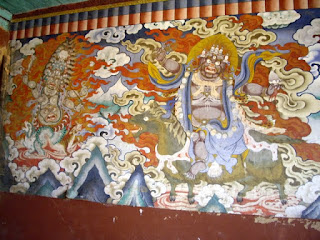Bhutan is a visually striking country; staying in Thimphu, the capital, for the entire month is wasting a fantastic opportunity. Kajil (my apartment mate, who is a pediatric emergency medicine fellow at Los Angeles Children’s hospital and also an HVO volunteer) hired a driver to take us to Punakha and Phobjikha, two of the most beautiful and interesting sites within reasonable distance of Thimphu.
We set out from Thimphu early Saturday morning, driving over incredibly winding, narrow, dangerous roads, steadily ascending, until we reached Dochu La. This is a mountain pass that gets us into the next valley. We were graced with the weather being clear, which is quite unusual, and had the opportunity to see the Himalayas in the distance. There are multiple religious monuments at the pass as well:
We continued on, descending through an Asian cloud forest, with lots of epiphytes, lichens, and evergreens. As we descended, it became warmer and there were some bananas and other tropical and semitropical fruits. Briefly, we saw some Assam macaques, reddish brown monkeys, but I couldn’t get a picture in time. We reached the Punakha valley, with a beautiful green river flowing through it, and came to the Punakha dzong, which was simply breathtaking. It is massive, and the inside was ornate and again, simply breathtaking.
We then passed through Wangdue. Wangdue also has a dzong, perched on the top of a cliff:
Wangdue is also where we passed through a road checkpoint; foreigners have to have a travel pass when crossing provincial boundaries. The town itself was strange in layout. The road snaked along a series of shack-like stores, ending in a large plaza filled with cars, surrounded by more shack-like stores. Our driver stopped to buy a bottle of whisky for his cousin, who was helping him take care of us.
We continued on, passing over incredibly bad and dangerous roads, and suddenly came to a halt. The road was being widened, and no traffic would pass for two hours while they worked, and then traffic would pass for two hours, back and forth all day. We fortunately arrived about 45 minutes before the gate opened, so we didn’t waste too much time.
 |
| This is BEFORE the construction zone! |
We continued on toward Phobjikha , our destination for the next day. Our driver was a nice guy, but kinda new at this, and he became repeatedly lost as we stumbled toward the guest house we would use for the night.
We finally arrived at the guest house, which requires some explanation. In addition to being a beautiful site, the Phobjikha valley is known for being one of the few wintering spots for black-necked cranes, a critically endangered species. One of the highlights of visiting Bhutan during the winter is seeing the cranes in the valley. If you are really lucky, you can see the mating dance (we weren’t that lucky). The guest house was actually two rooms in the Royal Society for the Preservation of Nature Crane Observation Center which were allegedly used by visiting scientists (although I’m not sure I completely believe this.) Now, in fairness, the rooms were labeled as guest rooms. Each contained two beds and some blankets. My room had a heater and a cabinet filled with six ancient Singer sewing machines. Kajil’s room did not come with a heater, and she had to ask for one, which was supplied. It was very, very cold in the rooms even with the heater, and I slept in my warmest fleece underwear under two huge, thick comforters. The bathroom was a Western toilet and a sink. Bring your own soap, (oops, forgot), toilet paper (remembered that one), and towel (yup, remembered that too.) No shower. However, it was free except for a small gratuity to the groundskeeper.
We ate dinner and breakfast the next day at a wonderful hotel about 100 meters up the hill from the observatory. The dining room was heated by a wood stove in the middle of the room, and we clustered around the stove as we ate good, hearty Bhutanese fare (I’ll do a posting on food in the near future).
The next morning, Kajil and I got up really early and went into the observatory room, which overlooked the valley. As the sun rose, we heard the squawking of the cranes, but could not see them. Then, gradually, more and more cranes flew into the valley, picking over the dry rice fields and foraging in the marsh. They are huge birds, easily bigger than a great blue heron. A couple of birds landed across the road from the observatory, quite close. As we had been locked into the guest center by the groundskeeper the night before, we climbed out a window and tried to get some closer pictures.
We then went for a walk through the valley with our driver’s cousin, who is a government naturalist. We bird-watched, visited the local monastery, and wandered through this beautiful glacial valley.
 |
| Typical old houses, built of mud and wood |
The 4 hour ride home was another white knuckle one for our driver, but we got home safely. On the way, we encountered more monkeys, this time able to get a couple of pictures.
All in all, a wonderful weekend.

























No comments:
Post a Comment